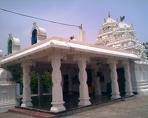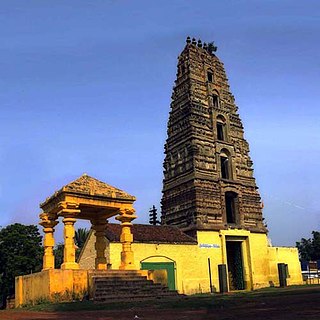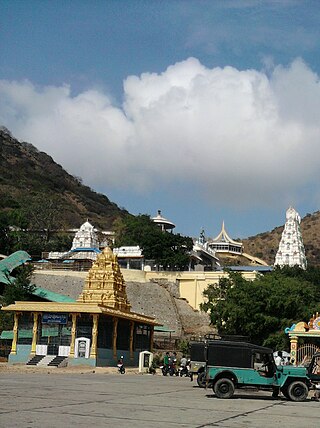
Coastal Andhra or Kosta Andhra is a geographic region in the Indian state of Andhra Pradesh. Vijayawada is the largest city in this region followed by Guntur. The region share borders with Rayalaseema region of the state and Telangana. It was a part of Madras State before 1953 and Andhra State from 1953 to 1956. According to the 2011 census, it has an area of 91,915 square kilometres (35,489 sq mi) which is 57.99% of the total state area and a population of 34,193,868 which is 69.20% of Andhra Pradesh state population. This area includes the coastal districts of Andhra Pradesh on the Circar Coast between the Eastern Ghats and the Bay of Bengal, from the northern border with Odisha to Rayalaseema in the south.

Machilipatnam, also known as Masulipatnam and Bandar, is a city in Krishna district of the Indian state of Andhra Pradesh. It is a municipal corporation and the administrative headquarters of Krishna district. It is also the mandal headquarters of Machilipatnam mandal in Machilipatnam revenue division of the district. The ancient port town served as the settlement of European traders from the 16th century, and it was a major trading port for the Portuguese, British, Dutch and French in the 17th century.
Gudivada is a city in Krishna district of the Indian state of Andhra Pradesh. It is a municipality and the headquarters of Gudivada mandal in Gudivada revenue division. It is one of the cities in the state to be a part of Andhra Pradesh Capital Region. It is the twenty-seventh most populous city in Andhra Pradesh and the three-hundredth most populous city in India with a population of 118,167 according to the 2011 Census of India.

Guntur district is one of the twenty six districts in the Coastal Andhra region of the Indian state of Andhra Pradesh. The administrative seat of the district is located at Guntur, the largest city of the district in terms of area and with a population of 670,073. It has a coastline of approximately 100 km (62 mi) on the right bank of Krishna River, that separates it from Krishna district and NTR district. It is bounded on the south by Bapatla district and on the west by Palnadu district. It has an area of 2,443 km2 (943 sq mi), with a population of 20,91,075, as per 2011 census of India.
Vuyyuru is a town in Krishna district of the Indian state of Andhra Pradesh. It is a Nagar panchayat and the headquarters of Vuyyuru Mandal. It is emerging as neighbourhood of Vijayawada, India situated 30 km away.
Nandivada is a village in Krishna district of the Indian state of Andhra Pradesh. It is located in Nandivada mandal of Gudivada revenue division. It is one of the villages in the mandal to be a part of Andhra Pradesh Capital Region. Geographically, it is 8 kilometres north of Gudivada and directly adjacent to the town of Sreenivasapuram.

Mopidevi is a village in Krishna district of the Indian state of Andhra Pradesh. It is the mandal headquarters of Mopidevi mandal in Machilipatnam revenue division. It is one of the villages in the mandal to be a part of Andhra Pradesh Capital Region. The village is known for its famous Lord Subrahmanyeswar Swamy Temple. The village is situated 80Km from Vijayawada and 30Km from Machilipatnam.

Movva is the name of a well-known village in the Krishna district of the Indian state known as Andhra Pradesh. It is located in 'Movva mandal of Machilipatnam revenue division'. It is one of the villages in the mandal to be a part of Andhra Pradesh Capital Region.
Nandigama is a town in NTR district of the Indian state of Andhra Pradesh. It is a Municipality and also the headquarters of Nandigama mandal in Nandigama revenue division.

Chebrolu is a village in Guntur district of the Indian state of Andhra Pradesh. It is the headquarters of Chebrolu mandal in Tenali revenue division. It was once a Buddhist site and territorial capital of Kakatiya dynasty. The Archaeological excavations revealed Buddhist artefacts of Satavahana and Ikshavaku period.
Kuchipudi is a village in Krishna district of the Indian state of Andhra Pradesh. It is also known as Kuchelapuram or Kuchilapuri. It is the origin of the eponymous dance form Kuchipudi, one of the eight major Indian classical dances. It is one of the villages in the Movva mandal to be a part of Andhra Pradesh Capital Region.

Sugguna Lanka is a village in Kollur mandal, located in Guntur district of Andhra Pradesh in India. The name of this village is derived from the Lastname Sugguna.
Pedaprolu is a village in Krishna district of the Indian state of Andhra Pradesh. It is located in Mopidevi mandal of Machilipatnam revenue division. It is a part of Andhra Pradesh Capital Region.

Amaravati is the capital city of the Indian state of Andhra Pradesh. It is situated in Guntur district at the heart of the state, on the right bank of the Krishna River and south west of Vijayawada. It is named after the historic Amaravathi site adjacent to Dharanikota, the ancient city, that served as the capital of the Satavahana dynasty more than 2,200 years ago. The Andhra Pradesh Capital Region encompasses the neighboring cities of Guntur, and Vijayawada.

Machilipatnam revenue division is an administrative division in the Krishna district of the Indian state of Andhra Pradesh. It is one of the 3 revenue divisions in the district with 12 mandals under its administration. Machilipatnam serves as the headquarters of the division. The division has 2 municipalities namely, Machilipatnam and Pedana.

Nuzvid revenue division is an administrative division in the Eluru district of the Indian state of Andhra Pradesh. It is one of the 3 revenue divisions in the district with 6 mandals under its administration. Nuzvid serves as the headquarters of the division. The division has 1 municipality.
Alinakhi Palem is a village near by Choragudi Panchayat present in Pamidimukkala mandal of Krishna district of Andhra Pradesh state, India. It is situated at an altitude of 09 ft above sea-level. A survey by Madras Office in 1926 by Sri Govindarajulu and LGB Firth displayed its assigned numbers. AP supplementary survey in 1965 by Sri V. Sriramulu included it in Gannavaram Taluk of Krishna district.

NTR district is a district in coastal Andhra Region in the Indian state of Andhra Pradesh. The district headquarters is located at Vijayawada. The district is named after former Chief Minister of Andhra Pradesh N. T. Rama Rao. The district shares boundaries with Guntur, Palnadu, Krishna, Eluru, Khammam and Suryapet districts.

Palnadu district is a district in coastal Andhra Region in the Indian state of Andhra Pradesh. With Narasaraopet as its administrative headquarters, it was formed on 4 April 2022 to become one of the resultant twenty-six districts The district was formed from Gurazala, Sattenapalli and Narasaraopet revenue divisions from Palnadu district. The district covers most of the Palnadu region.


















